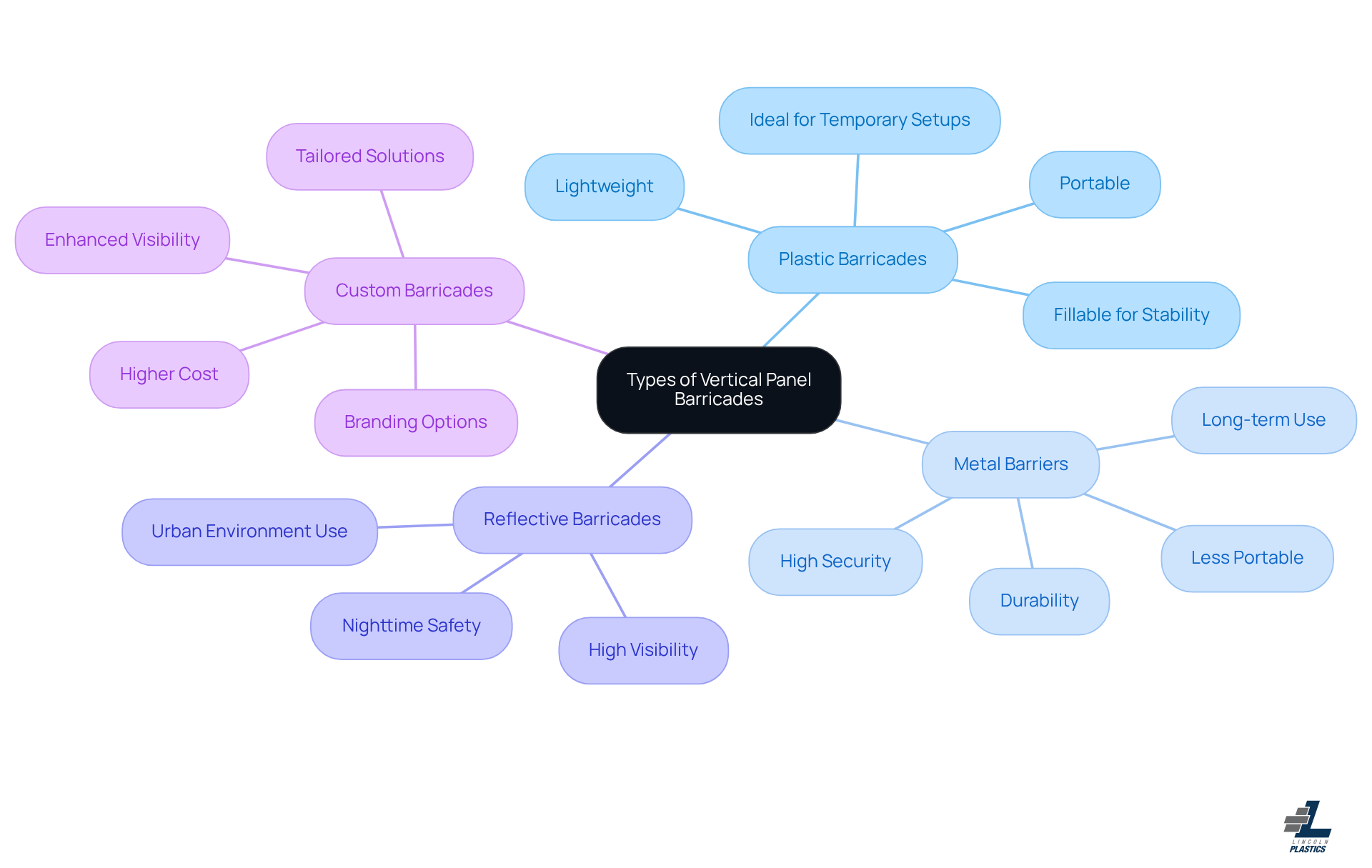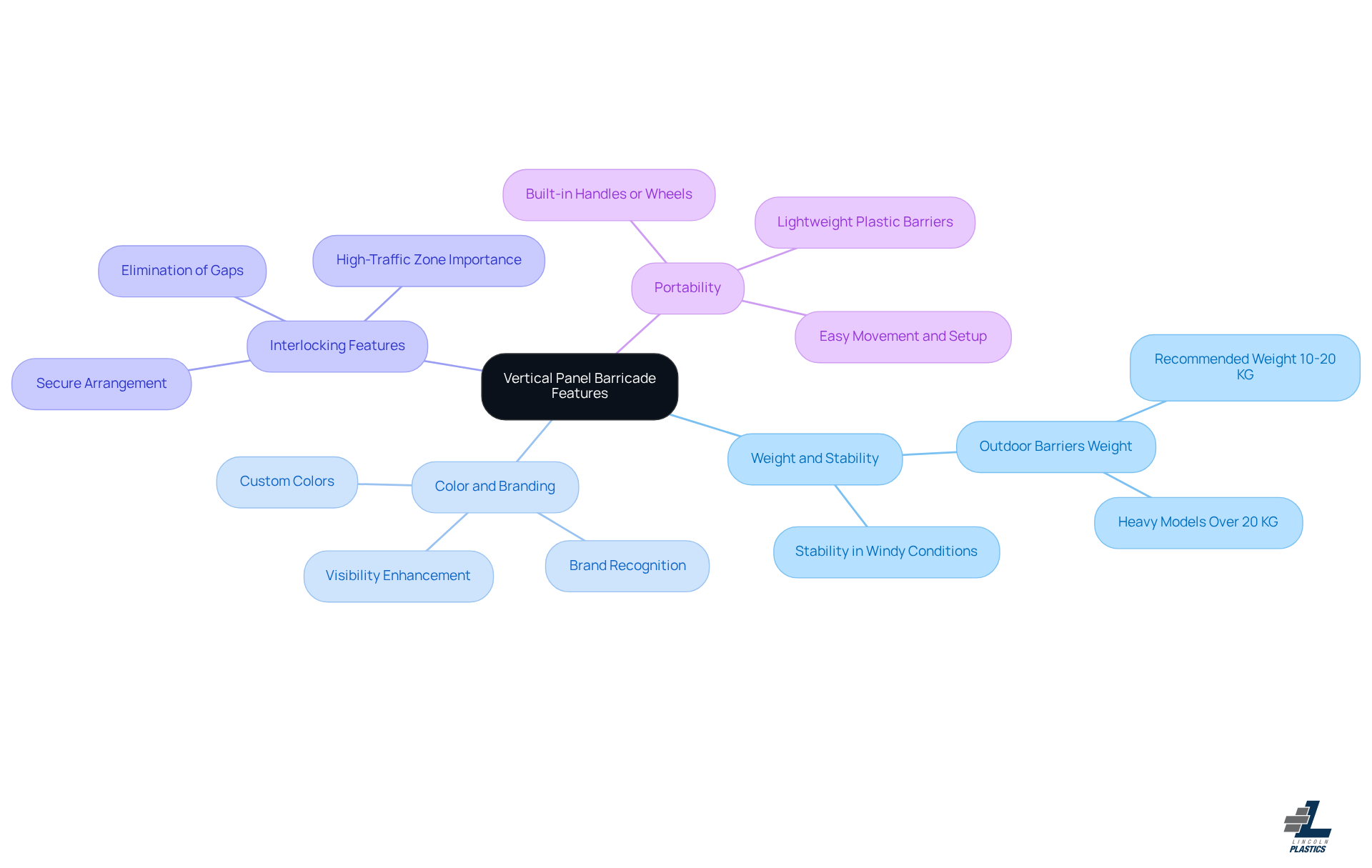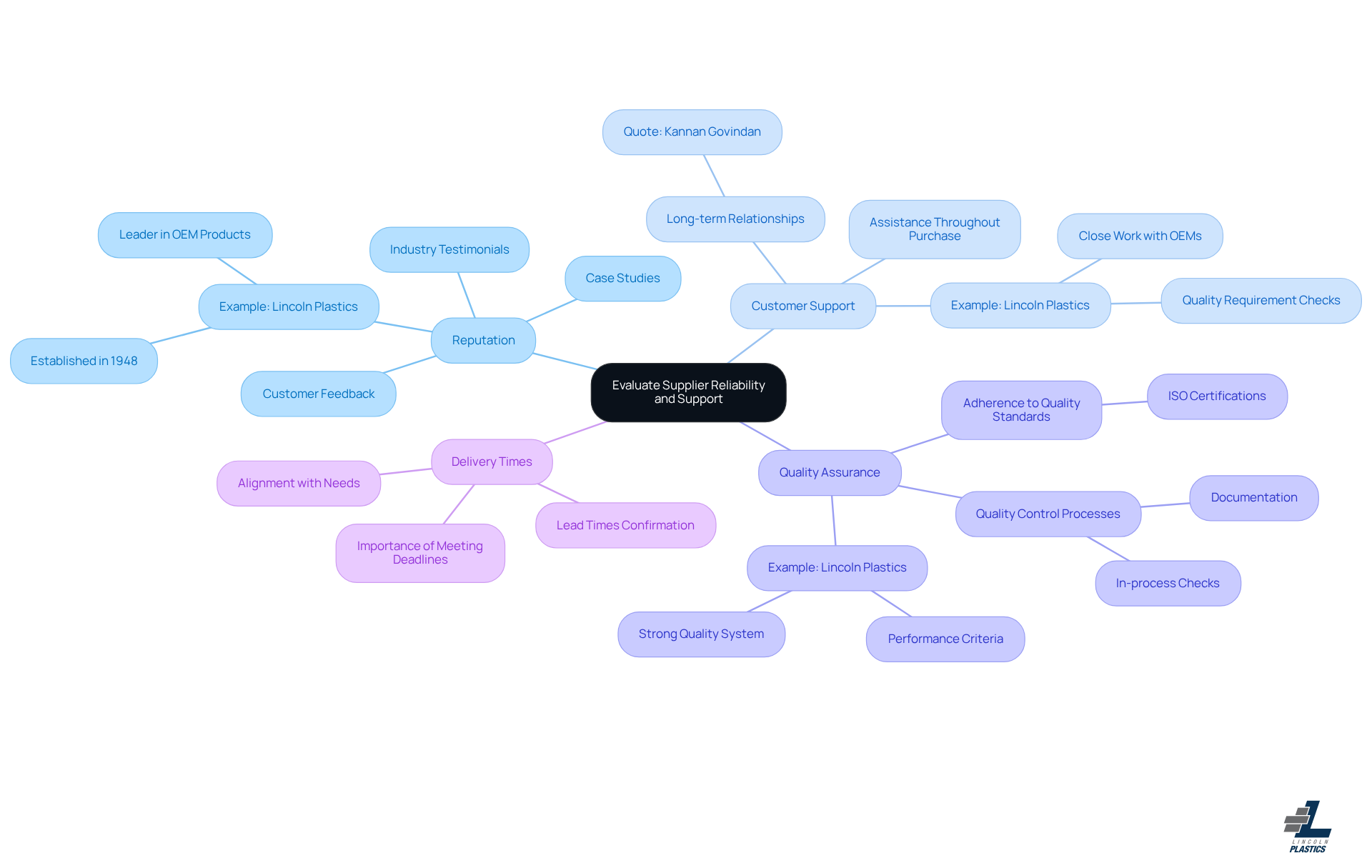
How to Choose the Right Vertical Panel Barricade for Your Needs
Overview
Choosing the right vertical panel barricade can feel overwhelming, right? But don’t worry! This article is here to help you navigate through the key considerations that matter most. We’ll look at project requirements, the types of barricades out there, essential features, and how to find reliable suppliers.
First off, understanding your project's specific needs is crucial. Think about the purpose of the barricade, where it will be located, and how long you’ll need it. These factors play a big role in ensuring safety, functionality, and compliance with regulations.
Next, let’s dive into the different types of barricades and their features. Each option has its own strengths, so it’s important to evaluate what works best for your situation. This way, you can make informed decisions that keep everyone safe and sound.
So, are you ready to tackle this challenge? Let’s get started on finding the perfect barricade for your project!
Introduction
Choosing the right vertical panel barricade can feel a bit overwhelming, right? With so many options out there and the unique needs of each project to consider, it’s easy to get lost. Safety and functionality are key, so understanding the different types of barricades and what makes each one special is super important for making a smart choice.
But with factors like purpose, location, and regulations to think about, how do you pick the best fit for your needs? This guide is here to break down the essential parts of barricade selection, giving you the insights you need to navigate through the complexities and boost your project’s success.
Identify Project Requirements and Objectives
Let’s start by taking a good look at what you really need for your project. When it comes to selecting vertical panel barricades, here are some key objectives to keep in mind:
- Purpose: First off, think about what the barricade is for. Is it for a construction site, an event, or maybe traffic control? Each of these uses might require different features and specifications.
- Location: Next, consider where the barricade will be used. Will it be indoors or outdoors? This choice greatly affects what materials you should go for. Outdoor barriers need to withstand the elements, while indoor options can focus more on looks and easy setup.
- Duration: How long will the barricade be in place? If it’s just for a temporary setup, you’ll want lightweight materials that are easy to assemble. Permanent installations, on the other hand, should prioritize durability and make sure they comply with local regulations.
- Protection Standards: Don’t forget to check out local regulations and protection standards for barricade use in construction sites as of 2025. Following these guidelines is crucial for keeping both workers and the community safe. Just to give you some perspective, there were 609 fatalities in work zones in 2012, which really underscores the importance of adhering to safety standards.
By clearly defining these objectives, you can make the selection process smoother and ensure that the vertical panel barricade meets all the necessary criteria. As industry specialists often say, "Evaluating goals is essential for efficient barrier selection, guaranteeing that security and functionality are prioritized." So, what might your project objectives look like? Perhaps you want to enhance visibility for aging drivers, minimize traffic conflicts, or ensure compliance with the latest safety regulations. Whatever it is, keeping these points in mind will help you make the best choice!

Explore Types of Vertical Panel Barricades
When you're picking out vertical panel barricades, it’s super important to know the different types out there and what each one brings to the table:
- Plastic Barricades: These are lightweight and a breeze to transport, making them perfect for temporary setups. You can fill them with water or sand for extra stability, which is especially handy for . Their portability means you can deploy and relocate them quickly, which is great for dynamic events.
- Metal Barriers: If you’re looking for durability, metal barriers are the way to go. They’re perfect for long-term use, especially in construction zones or high-security areas. They offer a solid level of security thanks to their robust build, but keep in mind they’re heavier and less portable than plastic options. So, while they might not be the best for temporary setups, they shine in permanent installations.
- Reflective Barricades: These are designed for high-visibility situations, making them crucial for nighttime or low-light conditions. They really boost safety by ensuring they’re easy to spot, which is vital in various environments, especially during events or in urban settings.
- Custom Barricades: If you want something tailored, custom barricades can include branding or specific features to meet your unique needs. They might cost a bit more, but they can significantly enhance visibility and functionality, making them a smart investment for businesses wanting to stand out.
As you weigh these options, think about factors like how fast you need to deploy them, their durability, and visibility. For instance, while plastic barriers might be your go-to for convenience in temporary situations, a vertical panel barricade could be essential for long-term security needs. Understanding these dynamics will help you choose a barrier that effectively meets your safety and operational goals.

Select Features and Customization Options
When you're on the hunt for a vertical panel barricade, there are a few key features and customization options you definitely want to keep in mind:
- Weight and Stability: You want a barricade that can handle whatever Mother Nature throws at it—think wind and crowd pressure. For outdoor events, sturdier barriers are a must to keep everything steady and prevent tipping. A good rule of thumb? Aim for outdoor barriers weighing between 10-20 KG for stability, and if you're expecting high traffic or windy conditions, heavier models over 20 KG are your best bet.
- Color and Branding: Custom colors and logos can really make your barricade pop! They not only enhance visibility but also boost brand recognition. By thoughtfully integrating these elements into your barricade design, you can create a cohesive look that truly reflects your project’s identity.
- Interlocking Features: Barricades with interlocking functions are a game changer. They provide a more secure arrangement, effectively eliminating gaps that could compromise security. This feature is especially crucial in high-traffic zones, as those gaps can lead to risks.
- Portability: Ever tried moving a barricade without handles or wheels? It’s not fun! Look for barriers that come with for easy movement, especially if you need to relocate them often. Lightweight plastic extendable barriers are perfect for indoor or short-term outdoor use, making transport and setup a breeze.
By carefully considering these characteristics, you can ensure that your barrier not only meets safety standards but also aligns perfectly with your branding and operational needs. So, what are you waiting for? Let's find the right barricade for you!

Evaluate Supplier Reliability and Support
When you're on the hunt for a reliable supplier for your vertical panel barricades, there are a few key things to keep in mind:
- Reputation: First off, check out the supplier’s reputation in the industry. Look for testimonials, case studies, and customer feedback. A solid reputation usually means a history of reliability and quality service. Take Lincoln Plastics, for instance. They've been a leader in OEM irrigation products and custom profile extrusion since 1948, and they’ve built a strong reputation for delivering high-quality solutions tailored to what clients need.
- Customer Support: Next up is customer support. How well does the supplier assist you throughout the purchasing process? You want someone who’s there for you, not just before the sale but after too. As Kannan Govindan puts it, "The willingness of suppliers towards building long-term relationships with manufacturers is as important as the capability of the supplier." Lincoln Plastics really shows this commitment by working closely with OEMs to ensure their products meet all quality requirements, including special checks for ‘fit and function’.
- Quality Assurance: Now, let’s talk about quality assurance. Make sure the supplier sticks to recognized quality standards, like ISO certifications. These certifications show they’re committed to maintaining high-quality control processes, which is super important for the durability and effectiveness of vertical panel barricades. Lincoln Plastics has a strong quality system that includes essential in-process checks and documentation to ensure all products meet specified dimensions and performance criteria, including tolerances that depend on the material and application.
- Delivery Times: Finally, don’t forget to confirm lead times and delivery schedules. You want to make sure they align with your needs. A reliable provider should consistently meet deadlines because that’s crucial for keeping your timelines intact.
By taking the time to evaluate these aspects—especially customer support and quality assurance—you can make a smart decision that boosts your project’s success.

Conclusion
Choosing the right vertical panel barricade is super important for keeping things safe and functional in various projects. By getting a handle on what your project specifically needs—like its purpose, location, duration, and how it stacks up against protection standards—you can make the selection process a lot easier and ensure that the barricade does its job well.
Throughout this article, we’ve highlighted some key things to think about, like the different types of barricades out there—plastic, metal, reflective, and custom options. Each type comes with its own perks, tailored to fit specific situations, whether you need something for a temporary setup, long-term security, or enhanced visibility. Plus, don’t forget to look at features like weight, stability, color customization, and how reliable your supplier is; these factors can really affect how effective the barricade is and how successful your project turns out.
In the end, making an informed choice about vertical panel barricades not only boosts safety but also helps create a more organized and efficient project environment. By taking the time to assess your goals and the options available, you can ensure that the barricade you choose meets all regulatory standards and aligns with what you’re trying to achieve. So, take a moment to think about your needs and choose wisely—after all, your project’s success really does depend on it!
Frequently Asked Questions
What should I consider when identifying project requirements for vertical panel barricades?
You should consider the purpose of the barricade (e.g., construction site, event, traffic control), the location (indoors or outdoors), the duration of use (temporary or permanent), and the applicable protection standards and local regulations.
How does the purpose of the barricade influence its selection?
The purpose determines the features and specifications required for the barricade. Different uses, such as construction, events, or traffic control, may necessitate different designs and materials.
Why is the location important when choosing a barricade?
The location affects the choice of materials; outdoor barricades need to withstand weather conditions, while indoor barricades can focus on aesthetics and ease of setup.
What factors should I consider regarding the duration of the barricade's use?
For temporary setups, lightweight materials that are easy to assemble are ideal. For permanent installations, durability and compliance with local regulations are more important.
Why is it important to check local regulations and protection standards for barricades?
Adhering to local regulations and protection standards is crucial for ensuring the safety of workers and the community. Non-compliance can lead to serious incidents, as highlighted by the fatalities in work zones.
What are some potential project objectives when selecting a barricade?
Project objectives may include enhancing visibility for aging drivers, minimizing traffic conflicts, and ensuring compliance with the latest safety regulations. Defining these objectives helps in making an informed selection.
List of Sources
- Identify Project Requirements and Objectives
- 10 Construction Quotes to Inspire Your Project (https://horstconstruction.com/10-wise-construction-quotes-to-inspire-your-next-project-2)
- 6 - Temporary Traffic Control | Ohio Department of Transportation (https://transportation.ohio.gov/working/engineering/roadway/manuals-standards/tem/06)
- Frequently Asked Questions: Barriers, Terminals, Transitions, Attenuators, and Bridge Railings (https://highways.dot.gov/safety/rwd/reduce-crash-severity/frequently-asked-questions-barriers-terminals-transitions-attenuators-and)
- Chapter 10. Construction/Work Zones (https://highways.dot.gov/safety/other/older-road-user/handbook-designing-roadways-aging-population/chapter-10)
- Safety Standards for Signs, Signals, and Barricades | Occupational Safety and Health Administration (https://osha.gov/laws-regs/federalregister/2002-09-12)
- Explore Types of Vertical Panel Barricades
- Vertical Panel Barricades | Stackable | Electriduct.com (https://electriduct.com/electriduct-vertical-panel-barricades.html)
- Crowd Control Barrier Market Share and Statistics 2035 (https://factmr.com/report/crowd-control-barrier-market)
- Step-N-Lock Vertical Panel - Stop For Pedestrians (https://trafficconesforless.com/step-n-lock-vertical-panel-stop-for-pedestrians.html)
- Vertical Panel Crosswalk Road Traffic Barricade 12" Wide (https://trafficconesforless.com/step-n-lock-vertical-panel-barricade-12-wide.html)
- Select Features and Customization Options
- How much do concrete barriers weigh? Concrete barrier weights explained (https://clearway.co.uk/news/how-much-do-concrete-barriers-weigh)
- Crowd Control Barriers: Metal vs Plastic Barricades (https://schoolfix.com/plastic-barricades-vs-steel-barrier-fences-which-is-best-for-you)
- Extendable Barriers: Types, Mechanisms & Weight Capacities Explained (https://birigroup.com/blog-details/Extendable-Barriers-Types-Mechanisms--Weight-Capacities-Explained)
- Tips For Choosing the Best Metal Barricade for Venue (https://soncocrowdcontrol.com/blog/crowd-control-barricades-for-event-venues)
- Weight Calculation of Filled Plastic Jersey Barriers | Water, Sand (https://tamiscorp.com/calculating-the-weight-of-filled-plastic-jersey-barriers)
- Evaluate Supplier Reliability and Support
- TTK Project Case Study: TTK in URSSAF Data Center, France (https://ttkusa.com/case_studies/ttk-project-case-study-ttk-in-urssaf-data-center-france)
- Solar Farm Security Fencing for Potash Farm | Case Study (https://alexandrasecurity.com/case_studies/security-fencing-for-milton-keynes-solar-farm)
- ATS Helps a Leading Auto Manufacturer Redefine EV Battery Assembly (https://atsindustrialautomation.com/case_studies/ats-helps-leading-auto-manufacturer-redefine-ev-battery-assembly)
- Supplier evaluation and selection: Criteria and methods (https://lawcode.eu/en/blog/supplier-evaluation-and-selection)
- Analysis of supplier evaluation and selection strategies for sustainable collaboration: A combined approach of best–worst method and TOmada de Decisao Interativa Multicriterio (https://onlinelibrary.wiley.com/doi/full/10.1002/bse.3374)


